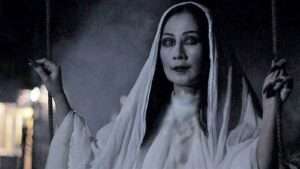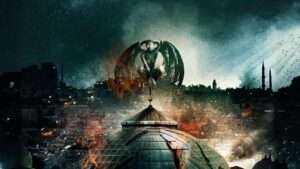Nokturno is a mesmerizing blend of psychological horror and gothic mystery that explores the fragile boundaries between grief, obsession, and the supernatural. Set in a small, decaying town, the story takes us on a haunting journey through one woman’s attempt to reconcile her past while unraveling the dark secrets of a cursed melody.
This article delves deep into Nokturno, unraveling its captivating story with spoilers, decoding its shocking plot twists, and explaining the thought-provoking ending. Whether you’ve watched the movie and are looking for clarity or are simply curious about its enigmatic plot, this breakdown will illuminate its haunting brilliance while sparking your curiosity.
Nokturno Movie Story (Spoiler Alert)
Nokturno opens with a hauntingly beautiful yet eerie tone, drawing us into the small, remote town of Arbour Hollow. The town, once thriving, is now a shell of its former self, plagued by strange occurrences and unexplained disappearances. The story centers on Evelyn Hart, a reclusive music teacher grappling with the trauma of her daughter’s death in a tragic accident. She isolates herself in her crumbling Victorian home, finding solace in playing the piano late at night.
One evening, Evelyn hears an unsettling melody faintly echoing through her home—a piece she never played but somehow knows. This is the first hint of a recurring theme: the blurring line between reality and illusion.
The Mysterious Melody
As Evelyn investigates the source of the melody, she discovers a dusty, handwritten music score tucked away in her piano bench. Titled Nokturno, the composition is cryptic and incomplete. Despite its unfinished nature, Evelyn becomes obsessed with playing it, feeling as though the music is guiding her toward something—or someone.
Evelyn’s obsession intensifies as she begins experiencing strange phenomena: shadows darting across the room, mirrors reflecting figures that aren’t there, and her late daughter’s laughter faintly echoing through the halls. She dismisses these as manifestations of her grief until she finds an old photograph hidden in her attic. The photograph shows a group of people dressed in 19th-century attire, posing in her living room. Among them is a woman who looks eerily similar to Evelyn herself.
The Hidden History of Arbour Hollow
Determined to uncover the truth, Evelyn visits the local historian, Thomas Gray, who reluctantly shares the town’s dark past. In the 1800s, the house Evelyn now inhabits belonged to a reclusive composer named Magnus Welby. Legend has it that Welby wrote Nokturno as a way to summon his dead wife’s spirit. The piece, however, was never completed, and Welby mysteriously vanished, leaving behind whispers of occult rituals and a curse tied to the melody.
The more Evelyn learns, the more her reality begins to unravel. She notices that every time she plays the music, the boundary between her world and the past weakens. One night, as she plays the final notes of the score, her surroundings shift. Her living room transforms into a grand parlor filled with ghostly figures, including Magnus Welby himself.
The Truth Behind the Melody
Evelyn confronts Magnus, who reveals the true purpose of Nokturno: it’s not just a way to summon the dead but a bridge to trap the living in a liminal space between life and death. Magnus had succeeded in reuniting with his wife but at the cost of being bound to this purgatorial realm. He warns Evelyn that by completing the melody, she risks the same fate.
Despite the warning, Evelyn sees an opportunity to reunite with her daughter. Torn between her desire for closure and the dangers of the melody, she makes a desperate choice. She completes the final passage, triggering a climactic sequence where time collapses, merging past, present, and future.
The Final Choice
Evelyn is given one final vision of her daughter, who begs her to let go. The moment is heartbreaking yet cathartic as Evelyn realizes that her love for her daughter doesn’t need to tether her to the past. With trembling hands, she destroys the score, breaking the curse.
As the house begins to crumble, Evelyn escapes, leaving the spirits of Magnus, his wife, and the other trapped souls finally free. The film ends with Evelyn standing outside her home, watching it burn. She hears the faint echo of her daughter’s laughter one last time—a bittersweet acknowledgment that her daughter has moved on, and now, so can she.
Setting the Stage for Analysis
Nokturno weaves an intricate tale of grief, obsession, and the human need for closure. Its haunting story raises questions about how far we’re willing to go to confront our past and what we’re willing to sacrifice for the illusion of what’s gone.
Read more, The Poughkeepsie Tapes Ending Explained
Explanation of Nokturno Movie Plot Twists
Nokturno excels at weaving unexpected twists into its narrative, creating a story that keeps viewers guessing until the very end. Here’s a breakdown of the movie’s most intriguing twists and their significance:
1. Evelyn’s Connection to the Past
One of the biggest twists in Nokturno is the revelation that Evelyn isn’t just a random occupant of the house—she’s deeply connected to its history. The photograph showing her doppelgänger in the 19th-century group implies that her lineage or soul is linked to the house’s cursed past. This twist reframes Evelyn’s obsession with the melody, suggesting it was not entirely her choice but something predestined or manipulated by the spirits tied to the music.
This twist taps into the theme of cyclical tragedy, as Evelyn unknowingly steps into the same path that doomed Magnus Welby. It forces the audience to question whether she has any real agency or if she’s just another pawn in the melody’s haunting legacy.
2. The True Purpose of Nokturno
The revelation that Nokturno is more than a simple composition—it’s a gateway to a liminal world—adds a chilling layer to the story. At first, Evelyn believes completing the score will give her closure by allowing her to reconnect with her daughter. Instead, Magnus reveals that Nokturno was designed to ensnare living souls in a timeless purgatory, ensuring they remain trapped alongside the dead.
This twist not only heightens the stakes but also reframes Magnus as both a victim and a warning. He mirrors Evelyn’s grief and desperation, showing what she might become if she allows her loss to consume her.
3. Evelyn’s Daughter’s Role
Perhaps the most emotional twist comes in the final act, where Evelyn’s daughter’s spirit intervenes to stop her. Instead of being a passive presence, the daughter actively urges Evelyn to let go of the past. This twist adds a poignant layer to the story, as it’s not just about Evelyn’s need for closure—it’s about honoring the memory of her daughter without sacrificing herself in the process.
These twists work together to create a narrative rich with suspense and emotional depth, making Nokturno more than just a ghost story. It becomes a meditation on grief, obsession, and the choices that define us.
Nokturno Ending Explained
The ending of Nokturno is as thought-provoking as it is haunting, leaving viewers with a mix of closure and lingering questions. Here’s a breakdown of the final moments and their deeper meaning:
Evelyn’s Final Choice
In the climax, Evelyn completes Nokturno, triggering a collapse of time and space. She’s transported to the liminal world, where she’s surrounded by the trapped souls of those who fell victim to the melody. Among them are Magnus and his wife, who beg her to join them, promising eternal reunion with her daughter.
But Evelyn’s daughter appears as a final, pivotal figure. In a heart-wrenching moment, she tells her mother, “It’s time to let me go.” This marks a turning point for Evelyn. Instead of succumbing to the melody’s lure, she destroys the score, severing its hold on her and the house. This act breaks the cycle, freeing the trapped souls and ensuring the melody can no longer claim anyone else.
The Burning House
The house’s fiery destruction symbolizes both a literal and metaphorical cleansing. Evelyn walks away as the past burns to the ground, a visual metaphor for her release from guilt and grief. The faint sound of her daughter’s laughter suggests that Evelyn’s sacrifice brought peace—not just for herself but for her daughter as well.
What It All Means
The ending leaves viewers with several key takeaways:
- Grief and Acceptance: Evelyn’s journey underscores the importance of accepting loss rather than clinging to it. By letting go, she honors her daughter’s memory without being consumed by it.
- Breaking the Cycle: The destruction of Nokturno represents the power of choice. Unlike Magnus, who became a prisoner of his grief, Evelyn chooses to confront it and move forward.
- Ambiguity and Mystery: While the movie resolves Evelyn’s arc, it leaves room for interpretation. Did the spirits truly move on, or do they still linger, waiting for the next occupant? This unanswered question keeps the story alive in the viewer’s mind.
The ending of Nokturno is both chilling and uplifting, a perfect blend of horror and humanity that stays with you long after the credits roll.
Personal Thoughts
Nokturno is a masterclass in blending psychological horror with emotional depth. Its gripping storyline and unexpected twists kept me hooked from start to finish. I loved how the movie explored grief and acceptance without losing its eerie, suspenseful edge. The haunting visuals and melancholic soundtrack added layers of tension, making the story both chilling and deeply moving.
While some questions remained unanswered, that ambiguity made it even more compelling. Nokturno isn’t just a ghost story—it’s a powerful reminder of the strength it takes to confront our past and let go. This is one film that lingers long after the credits roll.
Conclusion
Nokturno is more than just a horror movie—it’s an emotional journey through loss, healing, and the choices that shape our reality. Its clever use of symbolism and layered storytelling creates a cinematic experience that’s as thought-provoking as it is terrifying.
The movie’s lingering ambiguity leaves plenty of room for interpretation, making it a must-watch for fans of supernatural thrillers. What did you think of Nokturno’s twists and its bittersweet ending? Share your thoughts in the comments below, and let’s unravel this haunting masterpiece together.
Last updated on December 16th, 2024 at 08:09 am



